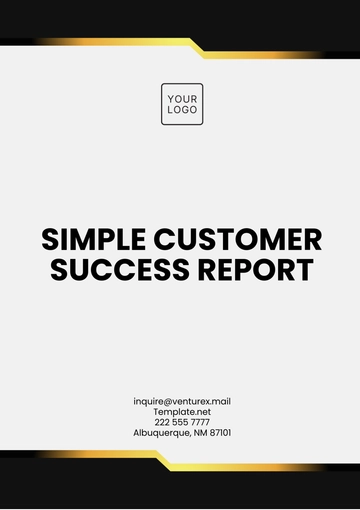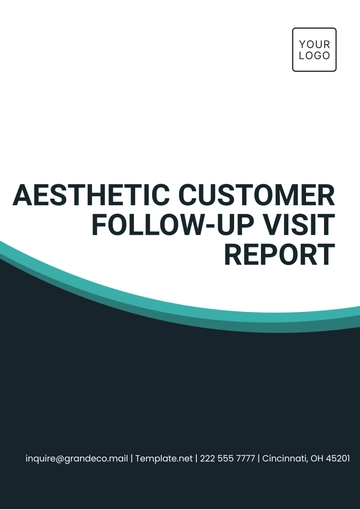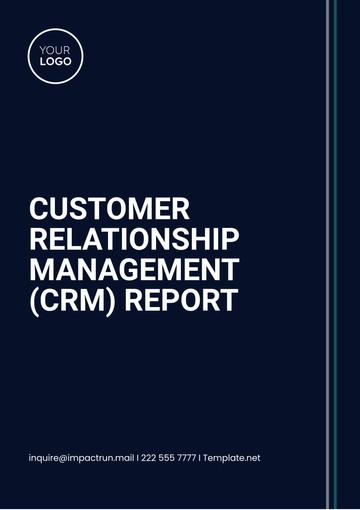Free Customer Experience Report

Prepared by: [Your Name]
Company: [Your Company Name]
Date: [Date]
I. Executive Summary
This Customer Experience Report provides an in-depth analysis of the interactions customers have with our products and services. The report highlights both areas of strength and key opportunities for improvement, enabling our organization to focus on actionable strategies that will elevate customer satisfaction and loyalty. Through comprehensive data analysis, we identified significant trends in customer behavior, preferences, and pain points.
Key findings reveal that while our product quality is consistently praised, improvements in customer service response times and pricing flexibility are essential to meet customer expectations fully. Based on these findings, strategic recommendations have been developed to address these issues and enhance the overall customer experience, contributing to long-term business success.
II. Introduction
The primary objective of this report is to evaluate the current state of customer experience across various touchpoints, including product usage, customer support, and pricing perceptions. By understanding the "voice of the customer," we aim to uncover gaps in service delivery and capitalize on opportunities to increase engagement and satisfaction. This report will serve as a guide for senior management and relevant departments to implement changes that will directly impact customer retention and overall business performance.
This report also aims to provide an actionable roadmap for implementing improvements based on customer insights, ensuring that our business remains competitive in a rapidly evolving market.
III. Methodology
A. Data Collection
The data for this report was gathered through a multi-channel approach, ensuring a comprehensive understanding of customer experiences. The key data sources included:
Online Surveys: Sent to a representative sample of recent customers, focusing on their satisfaction with the product, customer support, and pricing.
Follow-up Interviews: Conducted with a smaller subset of customers via phone to gain deeper qualitative insights into their experiences and specific pain points.
Customer Support Interaction Analysis: A review of customer service emails, live chat interactions, and support tickets to identify recurring issues and response quality.
Additional data was gathered from social media platforms and review sites to capture unsolicited feedback and gauge public perception of our brand.
B. Data Analysis
The collected data was analyzed through a combination of quantitative and qualitative methods:
Quantitative Analysis: Statistical tools were used to calculate customer satisfaction scores, and Net Promoter Scores (NPS), and identify trends in purchasing behaviors.
Qualitative Analysis: Thematic analysis was applied to interview transcripts, open-ended survey responses, and customer service interactions, enabling us to identify common themes and patterns in customer feedback.
We also compared current customer satisfaction metrics with historical data to assess trends over time, allowing us to track both improvements and emerging challenges.
IV. Key Findings
A. Customer Satisfaction Scores
The survey revealed the following satisfaction levels across key customer interaction categories:
Category | Satisfaction Score | Comments |
|---|---|---|
Product Quality | 85% | Customers consistently praised the durability and design. |
Customer Service | 78% | Many cited long wait times for responses as a concern. |
Pricing | 80% | While viewed as competitive, some felt that additional pricing options could offer better flexibility. |
Overall, customers are highly satisfied with the product quality, but there are clear opportunities for improving the speed and quality of customer support, as well as re-evaluating pricing structures.
B. Feedback Trends
The qualitative data revealed key customer sentiments:
Product Durability and Design: Customers regularly commended the robustness and sleek design of our products, particularly highlighting the longevity of key features. One customer noted, “I’ve been using the product daily for a year now, and it’s still as good as new.”
Customer Service Delays: A recurring issue was the delayed response from customer support, especially through email and chat services. One customer shared, “I had to wait three days just to get a reply, and that impacted my project timeline.”
Pricing Flexibility: Many customers expressed a desire for more flexible payment plans, particularly for bulk purchases or subscription-based models. A specific request included a tiered pricing system that better accommodates small business budgets.
C. Areas for Improvement
Based on these findings, we identified several critical areas for enhancement:
Customer Service Response Time: Many customers indicated that delayed responses, especially during peak hours, negatively impacted their overall experience. There is a clear need to enhance the efficiency of our support team.
Pricing Strategy: While our pricing is seen as competitive, there is a growing demand for more flexible pricing options such as payment installments, discounts for long-term users, or subscription-based models.
Online Shopping Portal: Customers have mentioned that the navigation on our online shopping portal is somewhat cumbersome, with one customer noting that it takes "too many clicks" to finalize a purchase. An overhaul of the user interface (UI) could enhance the shopping experience and reduce cart abandonment rates.
V. Recommendations
A. Enhance Customer Service
Immediate Training: Implement ongoing customer service training programs focused on efficiency and response quality. This includes training support representatives to handle multiple customer interactions simultaneously while maintaining high service quality.
Implement Live Support Bots: To address delays, we recommend integrating AI-driven chatbots to handle basic queries instantly, reducing the burden on human agents during peak times.
Service Level Agreement (SLA) Updates: Revise internal SLAs to ensure that customers receive responses within a guaranteed timeframe, aiming for an initial response within 24 hours and resolution within 48 hours.
B. Implement Feedback Loop
Structured Feedback System: Establish a formal feedback loop that continuously gathers and analyzes customer input. This should include post-purchase surveys, follow-up emails, and quarterly customer satisfaction assessments. Regularly reviewing feedback will allow us to make swift adjustments based on real-time customer experiences.
Customer Advocacy Program: Launch a customer advocacy program where loyal customers are invited to participate in beta testing and provide feedback on upcoming product features. This will not only engage our most passionate users but also offer direct insights into potential improvements.
C. Review Pricing Strategies
Flexible Pricing Models: Explore options for introducing new pricing models, such as pay-as-you-go or subscription tiers. These models would better accommodate varying customer budgets and needs.
Discounted Bundles: Introduce bundled offers where customers can purchase products or services at a discounted rate when bought in combination, thus providing more value and boosting overall sales.
VI. Conclusion
The insights gained from this Customer Experience Report reveal important opportunities for our organization to enhance customer satisfaction and build loyalty. The product quality is a clear strength, but improvements in customer service response times and flexible pricing options are crucial for meeting evolving customer expectations.
By implementing the recommended strategies—such as enhancing customer service capabilities, establishing a continuous feedback loop, and revising pricing models—we can ensure a more positive and seamless customer experience. This will not only increase customer satisfaction but also foster long-term loyalty, which is vital for sustaining growth in an increasingly competitive market.
- 100% Customizable, free editor
- Access 1 Million+ Templates, photo’s & graphics
- Download or share as a template
- Click and replace photos, graphics, text, backgrounds
- Resize, crop, AI write & more
- Access advanced editor
Introducing Template.net’s Customer Experience Report Template helps you track and document your customers' journey. Fully editable and customizable, this template ensures that you can modify it to suit specific business insights. Editable in our AI Editor Tool, you can easily adjust the format and content to deliver polished, professional reports.
You may also like
- Sales Report
- Daily Report
- Project Report
- Business Report
- Weekly Report
- Incident Report
- Annual Report
- Report Layout
- Report Design
- Progress Report
- Marketing Report
- Company Report
- Monthly Report
- Audit Report
- Status Report
- School Report
- Reports Hr
- Management Report
- Project Status Report
- Handover Report
- Health And Safety Report
- Restaurant Report
- Construction Report
- Research Report
- Evaluation Report
- Investigation Report
- Employee Report
- Advertising Report
- Weekly Status Report
- Project Management Report
- Finance Report
- Service Report
- Technical Report
- Meeting Report
- Quarterly Report
- Inspection Report
- Medical Report
- Test Report
- Summary Report
- Inventory Report
- Valuation Report
- Operations Report
- Payroll Report
- Training Report
- Job Report
- Case Report
- Performance Report
- Board Report
- Internal Audit Report
- Student Report
- Monthly Management Report
- Small Business Report
- Accident Report
- Call Center Report
- Activity Report
- IT and Software Report
- Internship Report
- Visit Report
- Product Report
- Book Report
- Property Report
- Recruitment Report
- University Report
- Event Report
- SEO Report
- Conference Report
- Narrative Report
- Nursing Home Report
- Preschool Report
- Call Report
- Customer Report
- Employee Incident Report
- Accomplishment Report
- Social Media Report
- Work From Home Report
- Security Report
- Damage Report
- Quality Report
- Internal Report
- Nurse Report
- Real Estate Report
- Hotel Report
- Equipment Report
- Credit Report
- Field Report
- Non Profit Report
- Maintenance Report
- News Report
- Survey Report
- Executive Report
- Law Firm Report
- Advertising Agency Report
- Interior Design Report
- Travel Agency Report
- Stock Report
- Salon Report
- Bug Report
- Workplace Report
- Action Report
- Investor Report
- Cleaning Services Report
- Consulting Report
- Freelancer Report
- Site Visit Report
- Trip Report
- Classroom Observation Report
- Vehicle Report
- Final Report
- Software Report





























